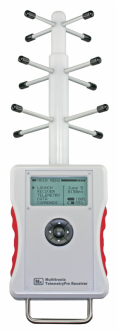|
Receiver Firmware 3.1 (Lisa voice)
Released: Sept. 2, 2016 Download this firmware and save it to your local hard drive. (Depending on your browser, you may have to right click and select "Save as...")
Use the Flight Data Analyzer software to update your receiver. Simply click 'Tools' on the Flight Data Analyzer menu bar and then select 'Update Firmware'. |
New features included in version 3.1
1. Added a new TRANSMIT POWER menu page that allows the power used by the transmitter prior to liftoff to be increased. Normally, the transmitter sends out data packets at 100mW prior to liftoff. Once liftoff occurs, the power is automatically increased to 500mW or 1W depending on the altitude and distance. By allowing the power used prior to liftoff to be increased, it is now possible for a receiver to be much further away from the rocket at liftoff and still maintain a solid downlink connection. This is really only needed if a receiver will be stationed more than a mile away from the launch pad. Which is usually only the case if a second or third receiver are stationed far away in order to help track a really high flight. The standard 100mW power settings is plenty for all other situations. It saves battery power and helps avoid overloading the receiver with too high a signal strength.
This new capability is also useful for ground testing to make sure other electronics located near the TelemetryPro transmitter will operate correctly even when the TelemetryPro transmitter is transmitting at full power.
The TRANSMIT POWER menu is accessed from: MAIN MENU --> LAUNCH --> RADIO LINK --> ADVANCED SETTINGS
2. Modified the algorithm that detects a shred so that it can also detect other flight anomalies at lower speeds such as a motor burn-through failure.
3. Modified the algorithm that announces that the main parachute deployment charge has fired. Previously, if the charge fired earlier than the expected altitude then it was possible the announcement would get skipped. It is now much more likely to be announced. However, it may still get skipped if the descent rate very quickly indicates the main has successfully deployed. In that case, rather than say the main charge has fired, Kate will just say the descent rate indicates the main has deployed.
This new capability is also useful for ground testing to make sure other electronics located near the TelemetryPro transmitter will operate correctly even when the TelemetryPro transmitter is transmitting at full power.
The TRANSMIT POWER menu is accessed from: MAIN MENU --> LAUNCH --> RADIO LINK --> ADVANCED SETTINGS
2. Modified the algorithm that detects a shred so that it can also detect other flight anomalies at lower speeds such as a motor burn-through failure.
3. Modified the algorithm that announces that the main parachute deployment charge has fired. Previously, if the charge fired earlier than the expected altitude then it was possible the announcement would get skipped. It is now much more likely to be announced. However, it may still get skipped if the descent rate very quickly indicates the main has successfully deployed. In that case, rather than say the main charge has fired, Kate will just say the descent rate indicates the main has deployed.



